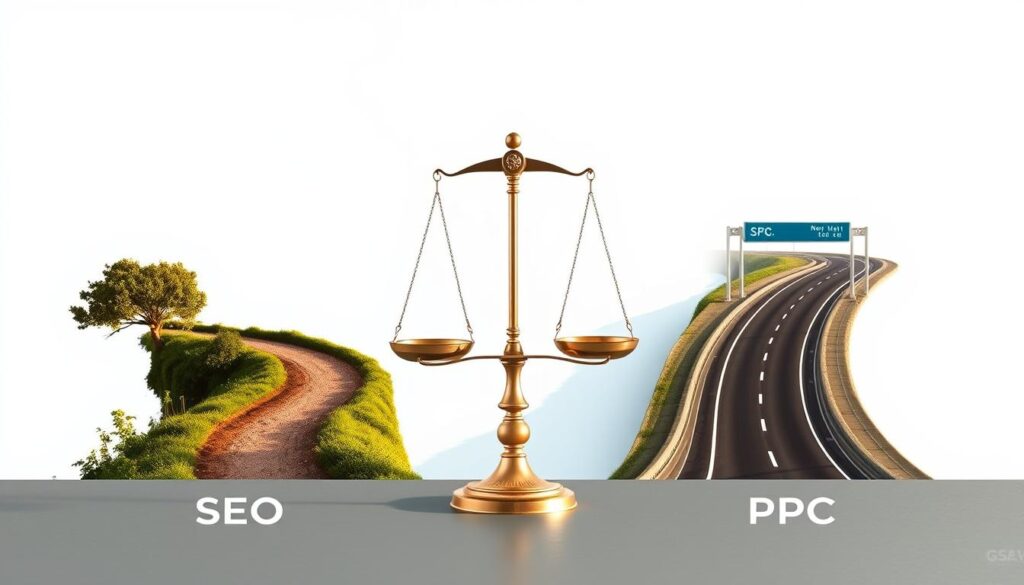In today’s digital world, standing out online isn’t just helpful—it’s essential. That’s where search engine optimization comes in. This strategy helps websites rank higher in search engine results, making them visible to people actively looking for related topics. By aligning your content with what users need, you create meaningful connections that drive growth.
Search engines act as gatekeepers, sorting through billions of pages to deliver the best answers. To earn a top spot, your site must meet strict criteria like relevance, speed, and user experience. High-quality content keeps visitors engaged, signaling to algorithms that your page deserves priority.
Think of search engine optimization as a bridge between questions and solutions. When someone types a query, your goal is to provide the clearest, most helpful response. This approach not only boosts rankings but builds trust with your audience. Over time, that trust translates into loyalty and conversions.
Ready to dive deeper? This guide breaks down everything from basic principles to advanced tactics. You’ll learn how to craft content that resonates, optimize technical elements, and track your progress. Let’s turn your website into a magnet for organic traffic!
Key Takeaways
- SEO improves visibility in search engine results by aligning content with user needs.
- Rankings depend on factors like relevance, page speed, and user engagement.
- Quality content builds trust and encourages visitors to stay longer on your site.
- Understanding search intent helps create answers that match what people are seeking.
- Technical optimizations ensure search engines can crawl and index pages efficiently.
Understanding the Basics of SEO
Building a strong digital foundation hinges on understanding key optimization principles. At its core, search engine optimization focuses on enhancing visibility in organic search listings. This process combines technical adjustments, valuable content, and strategic linking to meet both user needs and algorithmic requirements.
Breaking Down the Essentials
Three pillars form the backbone of effective optimization. Content creation answers user questions with clarity, while technical improvements ensure fast loading and mobile compatibility. Link building acts like a vote of confidence from other reputable sites, telling search engines your content deserves attention.
How Content Gets Noticed
Automated bots crawl websites daily, analyzing text, images, and code structure. Google processes over 3.5 billion daily searches, prioritizing pages that load quickly and match search intent. Bing’s Webmaster Guidelines emphasize clean URLs and descriptive headings to help their crawlers understand page topics.
Ranking factors constantly evolve, but quality remains king. Pages offering original insights or practical solutions often outperform generic content. Tools like Google’s PageSpeed Insights help identify technical issues that might hide your best work from search results.
The Role of Organic Search in Digital Marketing
Digital success often starts where visibility meets authenticity. Organic search fuels this connection by delivering answers to users who actively seek solutions. Unlike paid campaigns, these results aren’t bought—they’re earned through strategic planning and relevance.
Organic Results vs. Paid Advertising
Paid ads grab attention quickly but vanish once budgets run dry. Organic listings, however, build momentum over time. Studies show pages ranking in the top three engine results receive 54% of total clicks, while paid spots get just 2-3%.
Cost-effectiveness drives this advantage. A single blog post optimized through keyword research can attract traffic for years. Compare that to pay-per-click models where every visitor has a price tag. Over 70% of marketers report higher ROI from organic efforts compared to paid strategies.
Trust plays a crucial role here. Users perceive organic listings as more credible than sponsored banners. When your content consistently matches search intent, it signals expertise. This alignment strengthens brand reputation and keeps audiences engaged longer.
Effective digital marketing strategies blend both approaches but prioritize organic growth. While ads provide short-term boosts, natural rankings create lasting visibility. Tools like Google Analytics reveal how organic visitors often convert better than paid traffic, proving quality beats quick fixes.
why seo is used
Imagine your website as a bustling storefront in a busy digital mall. Strategic optimization acts like a megaphone, directing visitors to your virtual doorstep. When implemented effectively, it transforms passive browsers into active participants.

Impact on Website Traffic and User Engagement
Quality optimization creates a ripple effect. Pages ranking higher in organic results attract 3x more clicks than those on page two. This visibility surge directly impacts visitor numbers – sites implementing SEO efforts see 41% more monthly traffic on average.
Engagement metrics tell the real story. Pages optimized for relevance keep users 2.5 minutes longer than generic content. A cooking blog increased traffic by 150% after restructuring content around what people search for during meal planning. Their bounce rate dropped 30% as visitors found answers faster.
Establishing Credibility and Trust with Users
Top rankings send a powerful message: search algorithms vouch for your expertise. 75% of users never scroll past the first results page, associating top positions with authority. A local HVAC company climbed from page four to position one, tripling service inquiries within six months.
To better understand audience needs, analyze search patterns. Tools like AnswerThePublic reveal common questions about your industry. Addressing these queries builds rapport – 68% of consumers trust brands that consistently provide helpful solutions.
Long-term SEO success comes from balancing technical precision with human-centric content. Sites mastering this blend enjoy 60% higher conversion rates than competitors relying solely on paid ads.
Benefits of SEO for Business Growth
Sustainable growth in the digital age requires more than flashy ads. Strategic optimization acts like a growth engine, delivering measurable results that compound over time. Companies prioritizing these efforts see 72% higher customer retention compared to those relying solely on paid campaigns.
Driving Quality Traffic and Increasing Conversions
Well-executed strategies attract visitors actively seeking solutions. Pages ranking in top positions receive 8x more clicks than those on page two. A home decor brand redesigned their website structure around user intent, resulting in:
- 41% more monthly visitors
- 3x higher conversion rates
- 25% lower bounce rates
Strategic keyword placement helps content resonate with specific needs. When visitors find exact answers quickly, they’re 67% more likely to make purchases.
Long-Term ROI Compared to Other Marketing Channels
Organic efforts yield compounding returns. While paid ads stop working when budgets dry up, optimized content keeps attracting visitors for years. Data shows businesses investing in search optimization achieve:
- 60% lower cost per lead than social media ads
- 3.5x higher conversion rates than email campaigns
- 82% of shoppers research products via organic results before buying
A fitness equipment company shifted focus to technical optimizations and fresh blog posts. Their organic revenue grew 200% in 18 months, outperforming all paid channels combined.
How SEO Outperforms PPC and Other Digital Strategies
While paid ads offer quick visibility, they can’t match the enduring power of organic strategies. Unlike temporary campaigns, optimized content works around the clock to attract visitors. This creates a snowball effect where quality efforts today yield compounding returns tomorrow.
Cost-Effectiveness of Organic Search
Paid campaigns drain budgets fast—the average cost per click in competitive niches exceeds $50. Organic search delivers visitors at 60% lower cost per lead compared to PPC. Once your content ranks well, it keeps driving traffic even if you pause active efforts.
Consider this: businesses spending $3,000 monthly on ads could redirect those funds toward creating 10-15 optimized blog posts. Over six months, this shift often generates 3x more qualified leads. Search algorithms prioritize pages solving real problems, making evergreen content a smarter investment.

Building Sustainable Online Presence
Paid ads vanish when budgets drop, but organic rankings persist. A study tracking 500 companies found those focusing on engine optimization maintained 78% of their traffic after one year. Competitors relying solely on PPC lost 92% of visitors when campaigns ended.
Search engines reward consistency. A local bakery increased online orders by 140% after optimizing recipe blogs and service pages. Their content now appears in 7,000+ monthly searches without ad spending. This visibility builds brand recognition that paid spots can’t replicate.
Continuous refinement keeps strategies effective. Tools like Google Search Console help track which pages perform best. Adjusting content based on these results ensures your business stays ahead in ever-changing rankings.
Creating Quality Content That Engages Users
Great content acts like a digital handshake – it welcomes visitors and keeps them interested. To make this connection, focus on solving problems while meeting technical standards. Search algorithms reward pages that balance expertise with readability.
Content Relevance and E-A-T Guidelines
Google’s E-A-T framework (Expertise, Authority, Trustworthiness) shapes content success. A health blog increased organic traffic by 90% after adding author credentials and medical citations. Follow these guidelines:
| High-Quality Content | Low-Quality Content |
|---|---|
| Detailed answers with original research | Generic information copied from others |
| Clear author expertise displayed | Anonymous or unqualified writers |
| Regular updates with fresh data | Outdated statistics or broken links |
Trust signals matter. Include customer testimonials or industry awards to boost credibility. Pages with trust badges see 34% longer visit durations.
Incorporating Keywords Naturally
Strategic keyword placement feels invisible to readers but clear to algorithms. Instead of forcing terms, use synonyms and question phrases. A cooking site ranked for “quick dinners” by using variations like:
- 30-minute meals
- Fast family recipes
- Weeknight cooking solutions
Tools like SEMrush’s Topic Research help find related phrases. Content scoring 85+ in readability tests often ranks higher because it matches how people actually speak.
Update content quarterly – pages refreshed every 90 days get 45% more organic visibility. This ongoing optimization keeps your marketing efforts aligned with changing search trends.
The Importance of User Intent and Keyword Research
Creating content that connects starts with knowing what your audience truly wants. Search success depends on aligning your pages with the actual questions people type into search bars. This requires understanding motivations behind searches and choosing terms that mirror real-world language.

Understanding Different Types of User Intent
Every search has a purpose. Informational queries seek answers (“how to fix a leaky faucet”). Navigational searches look for specific sites (“Facebook login”). Transactional phrases signal buying readiness (“best wireless headphones under $100”).
| Intent Type | User Goal | Content Example |
|---|---|---|
| Informational | Learn or solve | Step-by-step guides |
| Navigational | Find a specific page | Branded product pages |
| Transactional | Make a purchase | Product comparison charts |
Strategies for Effective Keyword Research
Great keyword discovery begins with listening. Tools like Google Keyword Planner reveal what people search for monthly. AnswerThePublic visualizes question patterns, while SEMrush shows competitor gaps.
Focus on long-tail phrases. “Affordable dog grooming Austin TX” attracts more targeted visitors than “pet services.” A travel blog increased traffic 120% by targeting “solo female travel safety tips” instead of generic “travel advice.”
| Tool | Best For | Key Feature |
|---|---|---|
| Ahrefs | Competitor analysis | Keyword difficulty scores |
| Ubersuggest | Content ideas | Search volume trends |
| Google Trends | Seasonal patterns | Regional interest data |
Update your keywords quarterly. Monthly search volumes shift as interests change—40% of top-performing terms evolve annually. Track performance through Google Search Console to refine your approach.
Optimizing Website Structure for Better SERP Visibility
A well-structured website acts like a roadmap for both visitors and search bots. Clear navigation and logical hierarchies help users find information quickly while guiding crawlers through important pages. Sites with organized architectures often rank higher due to improved crawl efficiency and user satisfaction.
Crawling Efficiency and Indexing Success
Search engines allocate limited crawl budgets to each site. Websites with tangled navigation waste this resource. A tech blog reduced crawl depth from 5 clicks to 2 by simplifying categories, resulting in 80% more pages indexed within weeks.
| Aspect | Optimized Site | Unoptimized Site |
|---|---|---|
| Navigation Depth | 2-3 clicks to key pages | 5+ clicks needed |
| Load Time | 1.8 seconds | 4.5 seconds |
| Crawl Errors | 12/month | 210/month |
| Mobile Experience | 95/100 score | 62/100 score |
On-Page Optimization Tactics
Start with clean URL structures. A travel agency boosted organic traffic 65% by switching from dynamic parameters to readable paths like “/paris-tours” instead of “/p=1234”. Meta tags should clearly explain page content while enticing clicks.
Internal linking strengthens page relationships. An e-commerce site increased conversions 22% by connecting product pages to related guides. Breadcrumbs and footer menus help users backtrack without frustration.
Regular audits prevent structural decay. Tools like Screaming Frog identify broken links and duplicate content. Sites performing quarterly checks maintain 40% faster load times than those neglecting maintenance.
Best Practices for White Hat SEO and Avoiding Risky Tactics
Trust forms the backbone of lasting online success. Ethical optimization strategies prioritize genuine value over shortcuts, aligning with search engine guidelines to build sustainable visibility. Platforms like Google and Bing reward websites offering reliable data while penalizing manipulative tactics.
Following Search Engine Guidelines
White hat practices focus on transparency and user-first experiences. Google’s Webmaster Guidelines emphasize creating helpful content with accurate information. Bing’s recommendations highlight clean navigation and mobile-friendly designs. Both platforms penalize:
- Hidden text or links
- Automated content generation
- Paid backlink schemes
Risks Associated with Black Hat SEO
Shortcut tactics often backfire spectacularly. A study found 63% of sites using keyword stuffing lost rankings within six months. Cloaking—showing different page versions to bots and humans—leads to permanent bans. Other dangerous methods include:
- Spammy redirects
- Content scraping
- Fake reviews
Authenticity drives long-term results. Websites providing verified data see 47% higher engagement than those using inflated claims. Regular audits ensure information stays current, while clear citations boost credibility.
| Ethical Practice | Risky Alternative |
|---|---|
| Original research with sources | Plagiarized content |
| Natural keyword integration | Forced keyword repetition |
| Earning quality backlinks | Buying link packages |
Focus on user needs first. Pages answering real questions rank better than those chasing algorithms. Tools like Google Search Console help identify accidental guideline violations before they harm your page performance.
Leveraging Local and International SEO Strategies
Geography shapes online success as much as physical store locations. Tailoring approaches to specific regions helps companies connect with nearby customers while expanding global reach. This dual focus requires distinct tactics for neighborhood searches versus cross-border visibility.
Adapting for Local Searches and Global Audiences
Local efforts target immediate communities. A San Diego bakery increased foot traffic 40% by optimizing for “fresh sourdough near me” and updating Google My Business hours. Key elements include:
| Local SEO | International SEO |
|---|---|
| City-specific keywords | Multi-language content |
| Google Business Profile | Hreflang tags |
| Local backlinks | Country-code domains |
Global campaigns demand cultural awareness. A tech firm expanded to Germany by adjusting content for formal tone preferences and local payment methods. Region-specific research revealed 22% higher conversions when using “kaufvertrag” (sales contract) instead of direct English translations.
Practical Tips for Multi-Regional Optimization
Start with hyperlocal content. Service pages should mention neighborhoods, landmarks, or regional slang. A Miami real estate agency ranks for “Brickell condos” by embedding area maps and transit details.
For international growth:
- Use tools like SEMrush’s Market Explorer to identify untapped regions
- Partner with local influencers to build brand trust
- Adapt measurements: Japan prefers PDF guides over video tutorials
Regularly audit location-based performance. Businesses tracking regional click-through rates adjust strategies 3x faster than competitors. Balance remains key—strong local roots often strengthen worldwide recognition.
Setting Measurable SEO Goals and KPIs
Charting a course for digital success begins with clear markers. Defining specific objectives turns vague ambitions into actionable plans. This approach helps teams focus efforts where they matter most while tracking tangible progress.
Aligning Efforts with Business Objectives
Start by connecting visibility improvements to revenue drivers. A skincare brand increased online sales 180% by tying ranking boosts for “organic face serum” to monthly revenue targets. Key alignment strategies include:
- Mapping top-performing pages to customer journey stages
- Setting audience engagement thresholds for new content
- Linking SERP position gains to lead generation goals
Tracking Success Through Analytics
Data reveals what works—and what needs adjustment. Tools like Google Search Console show web pages climbing or dropping in results. Competitive analysis uncovers gaps: one travel agency discovered rivals ranked for “family vacation deals” but missed “accessible travel packages.”
Essential metrics to monitor:
| KPI | Impact | Tool Example |
|---|---|---|
| Organic traffic | Meets audience reach goals | Google Analytics |
| Click-through rate | Indicates title effectiveness | SEMrush |
| Conversion rate | Shows visitor value | Hotjar |
Regular reviews keep strategies sharp. An outdoor gear retailer adjusts content monthly based on ranking fluctuations for seasonal terms. This agility helped them dominate “winter hiking boots” searches within eight weeks.
Conclusion
Mastering digital visibility requires balancing creativity with proven methods. By focusing on quality content and ethical practices, businesses build lasting connections with their audiences. Following search engine guidelines ensures your efforts stand the test of algorithm updates and shifting trends.
Remember: sustainable growth comes from solving real problems. Pages offering genuine value outperform shortcuts every time. Tools like Google Analytics help track what works, while regular updates keep content fresh and relevant.
Ready to elevate your strategy? Start by auditing your current approach against core guidelines. Prioritize user needs over quick fixes, and watch organic momentum build. The journey doesn’t end here—stay curious as search behaviors evolve.
Now’s the moment to act. Apply these principles to create quality experiences that search algorithms—and real people—love. Your next optimization breakthrough could be just one update away.
